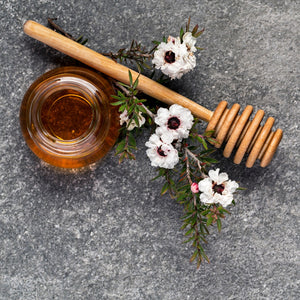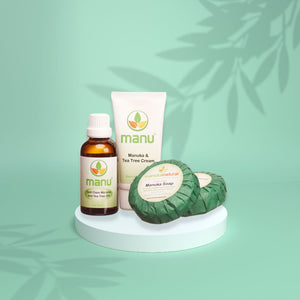How to Identify Manuka honey with special properties
When Professor Peter Molan of Waikato University in New Zealand first identified that Manuka honey from certain locations had special antibacterial and antifungal properties he referred to this as the Unique Manuka Factor or UMF.
Before we get into defining what causes UMF we need to accept that all honey has antibacterial properties due to the presence of glucose oxidase which, when in contact with serum of a skin wound produces hydrogen peroxide and hydrogen peroxide has a steralising effect on bacterial infection.
What Professor Molan discovered was that Manuka honey from certain locations contained this additional antimicrobial effect which is referred to as the ‘non-peroxide activity’.
UMF was initially measured against a standard test of Phenol or (carbolic acid, a commonly used antiseptic) concentration so that Manuka honey with a certification of UMF 10+ had the equivalent antimicrobial effectiveness as a 10% solution of Phenol.
This led to the Active Manuka Honey Association in New Zealand adopting and registering the name UMF as a trademark.
Subsequently it was discovered that one of the compounds in Manuka honey that gave it additional antimicrobial properties compared to honey from other floral sources was methylglyoxal.
There is a close relationship between the methylglyoxal concentration in certain types of Manuka honey and the UMF ranking.
UMF is a measure of the effectiveness of Manuka honey against a range of bacteria, whereas Methylglyoxal concentration is measured in mg/kg. These are closely related and the UMF certification level is now determined by the Methylglyoxal concentration rather than previous testing methods which involved adding Manuka honey to a controlled sample of cultured bacteria in a Petri dish and incubated for a standard period.
With this discovery and the vast opportunity for application in the medical profession came much higher demand from all over the world for this UMF honey which contained high levels of methylglyoxal compound.
Unfortunately this has also led to large amounts of honey being represented as Manuka honey when these examples may have little or no additional special properties when compared to honey from other floral sources.
In order to justify higher prices for this Manuka honey a whole lot of confusing terminology has been used to describe Manuka honey. Basic terms such as 15+, 20+ etc. have been added to labels without the UMF trademark which makes these numbers totally meaningless.
I recently saw Manuka honey labelled with 75+ which suggests to the layman that it has exceptional antimicrobial properties. This is definitely not the case as the highest ever recorded level of UMF is about 30+ and that would have been for a very small sample possibly less than 2 tonnes of honey from the whole of New Zealand.
When asked what the 75+ referred to the producer replied that this is the pollen count proving that it was genuine Manuka honey.
Fair enough but it did not make that clear on the label that it was pollen count so the inference was still there that it referred to the level of antimicrobial activity of this honey.
In fact this particular honey was harvested in the South Island of New Zealand where there is very little recorded additional antimicrobial activity in Manuka honey.
Therefore if you are intending to buy Manuka honey with additional antimicrobial propertied compared to normal honey you should look for Manuka honey that carries a registered UMFHA license #, that states clearly the UMF level of activity and that was packed in New Zealand.
PS The Manuka UMF honey sold on this website carries the UMFHA licensee # 1024



Leave a comment